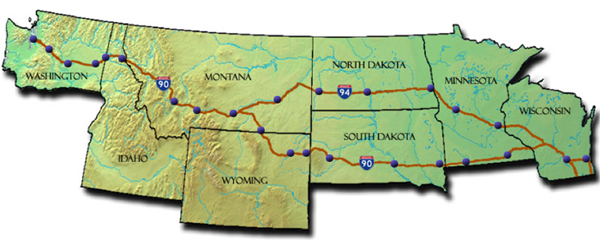

Idaho among states seeking to create
seamless information flow in I-90/I-94 corridor
Interstate 90 cuts a relatively short swath through northern Idaho – slightly more than 73 miles. But it plays a major role in linking motorists and commerce from Washington to Wisconsin – and the six states between.
ITD became part of an eight-state coalition – North West Passage" – in 2005 that focuses on creating a seamless traveler information system along the I-90 route and a northern I-94 loop that extends from eastern Montana to southern Wisconsin. The I-90 segment covers approximately 1,970 miles or roughly two thirds of the nation’s northern width.
Considered a rural interstate corridor, it carries a higher percentage of commercial traffic than most other interstates.
In addition to Idaho and the founding states of Minnesota, North Dakota and South Dakota, the coalition has grown to include Washington, Montana, Wyoming and Wisconsin. The Federal Highway Administration recognizes the I90/I94 North West Passage Corridor as a Transportation Pooled Fund (TPF) study.
The objective of the study, according to its website, is to influence ongoing standards development and use effective methods to share, coordinate and integrate traveler information across state borders.
“Using appropriate delivery systems, traveler information will be made available to internal staff and the traveling public via 511, Dynamic Message Signs (DMS) and other systems.”
The eight-state coalition was created to determine if and how a common format could be developed to share data among states. That process becomes more complex because the participating states are served by four separate 511 traveler information systems, explains ITD Mobility Services Engineer Bob Koeberlein, who represents Idaho on the coalition.
Each of the four systems has separate information gathering and dissemination standards, he said. The pooled fund study, using annual contributions by the eight states, is researching a way to develop standards for coordinating and sharing information … “a borderless flow of traffic and travel data.”
Koeberlein said the coalition is several years away from completing the seamless traveler information system.
The coalition also is considering how maintenance activities – especially winter snow removal or treatment – can be coordinated with adjoining states, and developing a memorandum of understanding that would allow cross-state responses to emergencies, Koeberlein explained.
Minnesota and the Dakotas laid the foundation for the corridor in 2003, and the other five states joined in 2005. Each now contributes $25,000 annually to help fund the study, cover travel expeenses and maintain a corridor website, i90i94travelinfo.com .
Washington assumes responsibilities for technical coordination while Minnesota serves as the administrative state. Representatives of the eight states participate in monthly conference calls and an annual meeting. Open Roads/Logic Tree works for the coalition as a private consulting firm.
The North West Passage recently received the Rural ITS (Intelligent Transportation System) 2010 award for Best New Innovative Practices. Each of the state representatives received an etched glass award for the honor.
Published 8-20-2010